The Fantastic Flute with Julia Escobar
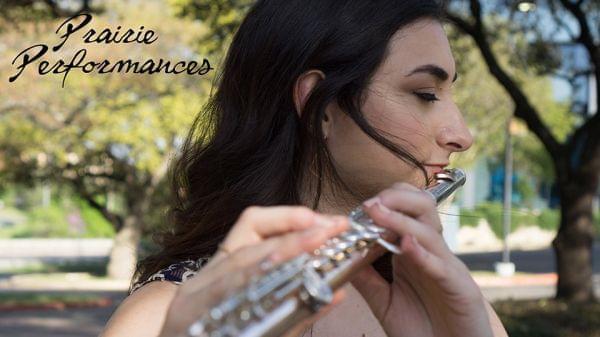
About the Program
“The Fantastic Flute” features pieces that contain orchestral flute writing at its finest. The goal of this program is to educate both musicians and non-musicians about the capacities of this instrument in a variety of musical settings. Additionally, flutists can gain valuable insights by listening to the full orchestral works from which famous “orchestral excerpts” (flute solos) originate. The selections heard in this program were chosen to provide a broad scope of styles in just two hours, with music spanning from the years 1727 to 2016.
Click below to read more about the pieces heard on "The Fantastic Flute" and curated by Julia Escobar.
- Prior Flute Concerto
- Dvořák Symphony 8
- Bach St. Matthew Passion
- Beethoven Symphony 7
- Brahms Symphony 1
- Stravinsky The Firebird Suite
Meet Julia Escobar
John Frayne Classical Music Graduate Student Work Experience Fellow
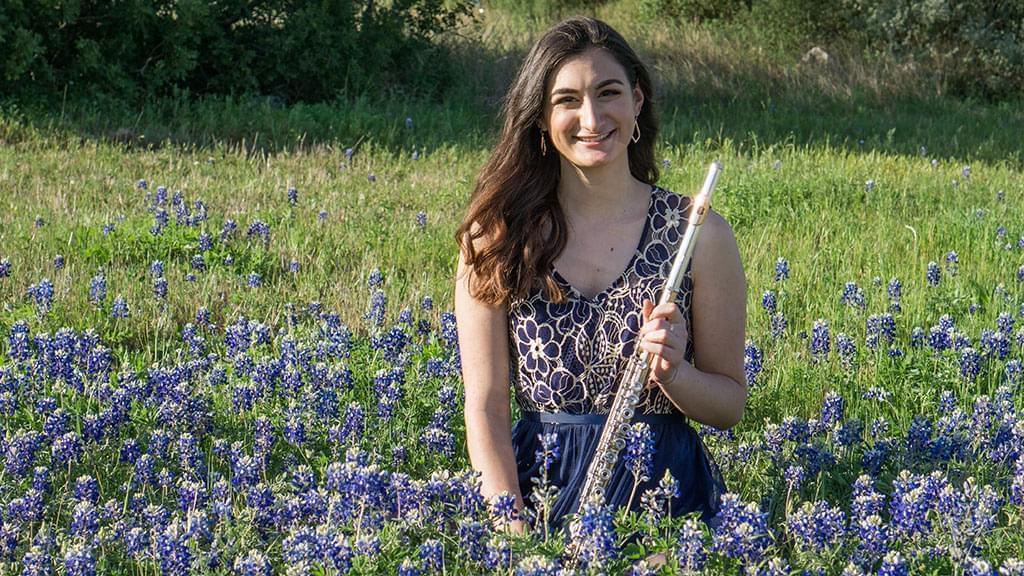
Julia Escobar
Hello, I’m Julia Escobar, guest host for this special edition of Prairie Performances. I am the first John Frayne Classical Music Graduate Student Work Experience fellow here at Illinois Public Media. I am in my first year studying for my Doctorate in Flute Performance and Literature at the University of Illinois. I got my Master’s in Flute Performance here as well, and my Bachelor’s at Texas State University. I am originally from Austin, Texas. Along with performing the flute, I am very passionate about teaching, which is a life-long professional goal of mine. Aside from being a student and working, I enjoy spending time with my adorable kitten, Cora, being with friends, and making jewelry.
Prior Flute Concerto
Sinfonia da Camera performing, led by Ian Hobson and featuring Jonathan Keeble as flute soloist
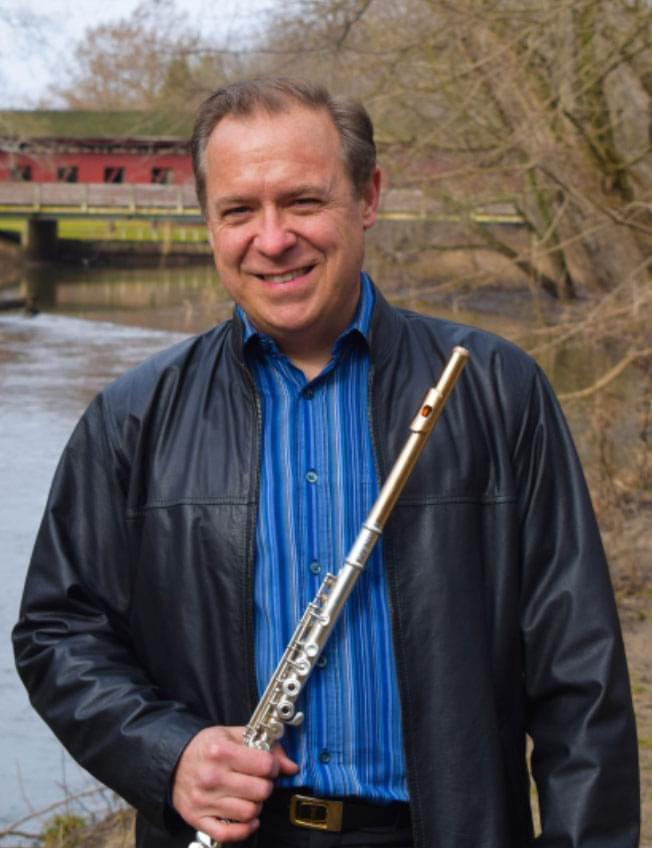
Jonathan Keeble
Richard Prior is the Music Director and Conductor of the LaGrange Symphony Orchestra and former Emory University Faculty. His Flute Concerto was written for his colleague and friend, Jonathan Keeble, who is the esteemed Professor of Flute at University of Illinois. Not only does Jonathan Keeble serve as the flute soloist on this piece, he also serves as the central figure and mentor for Julia’s master and doctoral degrees. So, it was an honor to include him and celebrate his work on this program. The work is also dedicated to Prior’s father. The second movement is in remembrance of Shira Banki. For more information, see Prior’s program notes via this Google Doc.
Dvořák Symphony 8
Champaign-Urbana Symphony Orchestra, led by Stephen Alltop and featuring Mary Chapman on principal flute
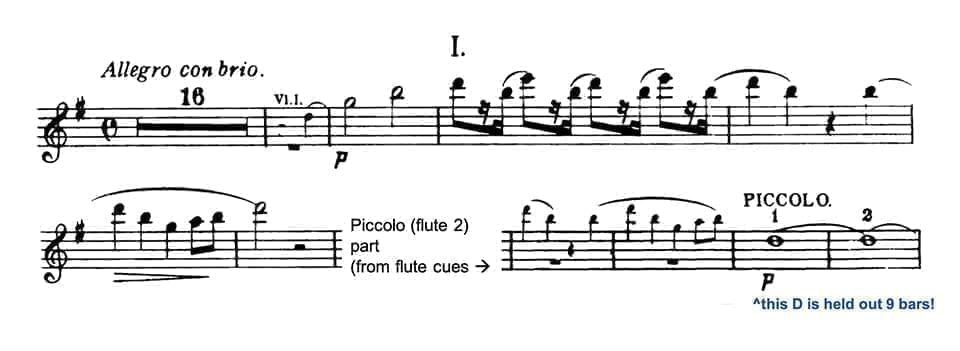
Dvořák's flute solo, Allegro con brio
Antonín Leopold Dvořák (1841-1904) wrote this symphony after being elected as a member of the Bohemian Academy of Science, Literature, and the Arts. His precious garden in Vysoká, Czech Republic served as an artistic muse. As such, Symphony 8 is infused with Bohemian folk themes throughout; it breathes of fanfare, triumph, and nostalgia. And actually, a perfect example of said "triumph" is the opening of the fourth movement, with the two trumpets singing a fanfare melody in unison.
Set in four movements, the work premiered in Prague in 1890. Dvořák depicts different characters and colors through modal mixture, varied rhythms, and thoughtful orchestration. Each movement is melodically saturated, and the melodies often repeat in different contexts, allowing for the listener to daydream for meaning. All of the movements feature the principal flutist in some capacity, but particularly the first and fourth are of focus.
- I. Allegro con brio
- II. Adagio
- III. Allegro grazioso
- IV. Allegro ma non troppo
Solos:
Movement I: After a lugubrious opening, darkness turns to light. This is the first statement of this theme, which recurs throughout the first movement, and a modified version resurfaces in the fourth. At times, we hear it in a minor mode, in longer note values, or from different instruments. Projection is at play here, with just one flute singing above a sea of tremolo-ing strings. The principal flute passes the baton to flute 2/piccolo with the final note of this short solo. The piccoloist is tasked to enter on that last D in-tune with the flute in unison, and with the rest of the orchestra - without running out of air!
Movements II-III contain solos as well, but they are slightly less featured. There are many beautiful duets with oboe in the Adagio, that are also tricky for intonation and blending.
Movement IV: Here we find an extended solo, which is the main flute solo of this symphony. It requires incredible rhythmic accuracy, light fingers, excellent projection above the orchestra, strategic breath control, and more.
View Dvořák's score here. (pgs. 10-11 contain the mvt. IV solo)
Bach St. Matthew Passion
Sinfonia da Camera performing, led by Ian Hobson
This excerpt is an aria from Part II of the sacred oratorio, St. Matthew Passion by J.S. Bach (1685-1750). Written in 1727, this lengthy piece is composed for vocal soloists portraying figures from the Luther Bible, a double choir, and a double orchestra. The famous "Aus Liebe" aria (section Mt 27:23a, no. 49) contains an extended solo for traverse flute. The first line is “Aus Liebe will mein Heiland sterben,” which translates to “Out of love my Savior wants to die.” Bach depicts this certain anguish in the instrumental and vocal parts with suspensions, stressing chromatic tones, and the melancholy A minor key. The introduction before the soprano entrance contains an oboe duo (written for oboe da caccia; Baroque oboe) playing simple chords on each beat, which provides a procession-like feel. The florid flute part foreshadows the feelings to be sung by the soprano.
This was written for a one-keyed wooden transverse flute, which was the flute played at that time, before the invention of the modern key system. It has a mellower timbre than that of the modern flute, and due to the tuning system, dissonances sounded even more crunchy. Given the genius of Bach, he likely was aware of this flute’s idiosyncrasies, and used them to his advantage for color.
Beethoven Symphony 7
Sinfonia da Camera performing, led by Ian Hobson

Beethoven's flute solo, Vivace
Ludwig van Beethoven (1770-1827) conducted the premiere of his seventh symphony at a time when the composer was almost completely deaf. Premiered in 1813, Beethoven’s Symphony 7 was famously regarded by Richard Wagner as “the Apotheosis of the Dance itself.” Dance-like music can be heard throughout the symphony, but particularly in the first movement, played on our program, “The Fantastic Flute.” Its title is “Poco sostenuto, Vivace.” The “Poco sostenuto” introduction is said to be the longest introduction in all of Beethvoen’s symphonies.
Then in the Vivace, we hear a spritely melody evocative of a courtly dance in the flute solo. The flute solo is in conversation with the principal oboe. Some have interpreted this theme as bird-like, which is a common representation of the flute in orchestral pieces. In our program alone, we hear the flute representing a bird motif in at least Dvořák's Symphony 8 and Stravinsky’s The Firebird Suite.
Brahms Symphony 1
University of Illinois Symphony Orchestra, led by Donald Schleicher
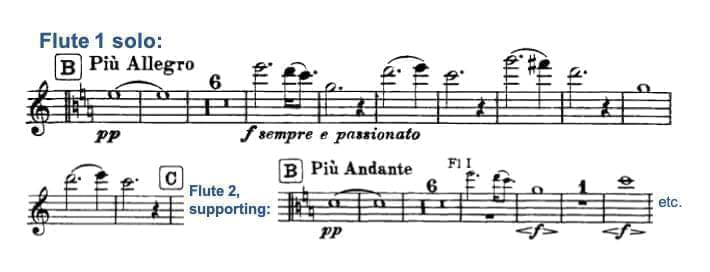
Brahms' flute solo, Più andante
Symphony no. 1 by Johannes Brahms (1855-1876) was a long time coming. It took him about 15 years on-and-off to write, as he was strife with internal and external pressure to create something unique and profound. He felt the weight on his shoulders of the renowned Beethoven, and was certainly influenced by him, but wanted to stray from merely imitating the legend’s compositional language. When the work was finally released, Brahms wrote of it, “my symphony is long and not particularly lovable.” Many would disagree with that statement! His Symphony 1 is a fairly substantial work, over 40 minutes long and set in four movements, following a classical symphonic form. “The Fantastic Flute” includes movements three and four:
- III. Un poco allegretto e grazioso
- IV. Adagio — Più andante — Allegro non troppo, ma con brio — Più allegro
In the “Più andante” section of the fourth movement, there is a brief yet impactful flute solo, which follows a horn call motive. This solo is apt for practicing and demonstrating a flutist’s fullest, yet clear and in-tune sound. The first flute and second flute must blend impeccably, as the second, fourth, and sixth measures of the solo overlap, giving the principal flutist a chance to breathe.
Stravinsky The Firebird Suite
Champaign-Urbana Symphony Orchestra, led by Stephen Alltop
The Firebird ballet, with music composed by Igor Stravinsky (1882-1917), premiered in 1910. This put the young Russian composer on the map, leading to his subsequent fame with Petrushka (1911) and Rite of Spring (1913), both of which were also collaborations with the Ballets Russes. Sergei Diagilev, founder and lead impresario for the Ballets Russes, sought out Stravinsky after running out of options for more well-known Russian composers. It worked out: the music for these ballets solidified Stravinsky as a revolutionary and influential composer of the 20th century. The story is a hybrid between Russian folk (via themes and characters) and original mystical elements.
The Firebird Suite was adapted from the full score of the ballet and premiered in 1911. It was later revised in 1919 and 1945. The selection for this program is from the 1919 version of the suite. We include a sample from the first movement in this program, titled "Introduction – The Firebird and its dance – The Firebird's variation."
The Firebird’s Variation, which is the last part of the first movement, contains the most challenging flute solo you'll hear on "The Fantastic Flute." The tricky key signature of F# major, awkward finger passages, and interval gymnastics make it quite the task to prepare. As the score indicates, the piccolo has a similarly difficult solo part, which sometimes responds to or anticipates the flute lines. You can see Stravinsky’s liberal treatment of accidentals for color.

